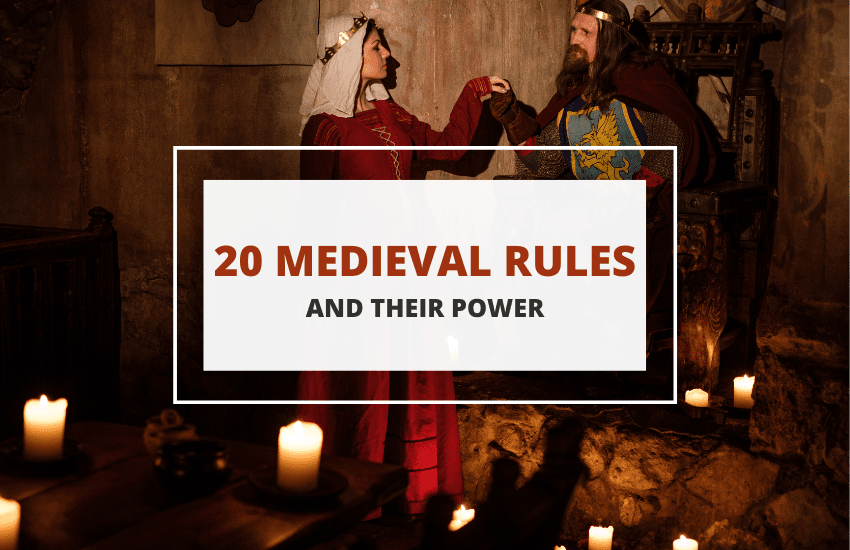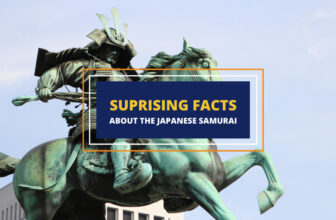
Table of Contents
Middle Ages was truly a tough time to be alive. This turbulent period spanned several centuries, from the 5th to the 15th centuries, and during these 1000 years, many changes swept through European societies.
After the fall of the Western Roman Empire, the people of the Middle Ages saw many transitions. They entered the Age of Discovery, struggled with plagues and diseases, opened to new cultures, and influences from the East, and waged terrible wars.
Given how many turbulent events happened in these several centuries, it is truly hard to write about the Middle Ages without considering the changemakers: Kings, queens, popes, emperors, and empresses.
In this article, let’s take a look at 20 medieval rules who wielded great power and were crucial during the Middle Ages.
Theodoric the Great – Rein 511 to 526
Theodoric the Great was the king of the Ostrogoths ruling in the 6th century in the area that we know as modern-day Italy. He was the second barbarian that came to rule over vast lands that stretched from the Atlantic Ocean to the Adriatic Sea.
Theodoric the Great lived in the period after the demise of the Western Roman Empire and had to deal with the results of this huge societal transition. He was an expansionist and sought to take control over the provinces of the Eastern Roman Empire, always setting his gaze to Constantinople.
Theodoric was a shrewd politician with an imperialist mindset and tried to find large areas for the Ostrogoths to live. He was known to murder his opponents, even in theatrical ways. The most famous account of his brutality was his decision to kill one of his opponents, Odoacer, at a feast and slaughter even some of his loyal followers.
Clovis I – Rein 481 to c. 509
Clovis I was the founder of the Merovingian dynasty and was the first king of the Franks. Clovis united the Frankish tribes under one rule and set up a system of government that would rule over the Frankish Kingdom for the next two centuries.
Clovis’ reign began in 509 and ended in 527. He ruled over sweeping areas of modern-day Netherlands and France. During his reign, he tried to annex as many regions as he could of the collapsed Roman Empire.
Clovis caused a huge societal shift when he decided to convert to Catholicism, causing a widespread wave of conversion amongst the Frankish people and leading to their religious unification.
Justinian I – Rein 527 to 565
Justinian I, also known as Justinian the Great, was the leader of the Byzantine Empire, commonly known as the Eastern Roman Empire. He took over the reins of the last remaining part of the Roman Empire that was once a great hegemony and that controlled most of the world. Justinian had a great ambition to restore the Roman Empire and even managed to recover some territories of the collapsed Western empire.
Being a skilled tactician, he expanded to North Africa and conquered the Ostrogoths. He also took Dalmatia, Sicily, and even Rome. His expansionism led to the great economic rise of the Byzantine Empire, but he was also known for his readiness to subjugate smaller peoples under his rule.
Justinian rewrote the Roman law that still serves as the basis of civil law in many contemporary European societies. Justinian also built the famous Hagia Sofia and is known as the last Roman emperor, while for Eastern Orthodox believers he earned the title of the Saint Emperor.
Emperor Wen of the Sui dynasty – Rein 581 to 604
Emperor Wen was a leader that left a permanent mark on the history of China in the 6th century. He unified the northern and the southern provinces and consolidated the power of the ethnic Han population over the entire territory of China.
Wen’s dynasty was known for its frequent campaigns to subjugate ethnic nomadic minorities to the Han influence and convert them linguistically and culturally in a process that was known as Sinicization.
Emperor Wen set the foundations of the great unification of China that will echo for centuries. He was a renowned Buddhist and reverted a societal decline. Although his dynasty did not last for long, Wen created a long period of prosperity, military might, and food production that made China the center of the Asian world.
Asparuh of Bulgaria – Rein 681 to 701
Asparuh united the Bulgars in the 7th century and established the First Bulgarian Empire in 681. He was considered the Khan of Bulgaria and decided to settle with his people in the delta of the Danube River.
Asparuh managed to enlarge his lands rather effectively and create alliances with other Slavic tribes. He expanded his possessions and even dared to carve out some territories from the Byzantine Empire. At one point, the Byzantine Empire even paid an annual tribute to the Bulgars.
Asparuh is remembered as a hegemonic leader and father of the nation. Even a peak in Antarctica is named after him.
Wu Zhao – Rein 665 to 705
Wu Zhao ruled in the 7th century, during the Tang dynasty in China. She was the only female sovereign in Chinese history and spent 15 years in power. Wu Zhao expanded the borders of China while tackling inner issues like corruption in the court and revitalizing the culture and economy.
During her tenure as the Empress of China, her country rose in power and was considered one of the greatest powers of the world.
While being very attentive to solving domestic issues, Wu Zhao also set her sights on expanding Chinese territorial limits deeper into Central Asia and even waging wars on the Korean Peninsula. Besides being an expansionist, she made sure to invest in education and literature.
Ivar the Boneless
Ivar the boneless was a Viking leader and a semi-legendary Viking leader. We know that he was indeed a real person that lived in the 9th century and was the son of the famous Viking Ragnar Lothbrok. We do not much as to what “Boneless” exactly means but it is likely that he was either completely disabled or experienced some difficulties while walking.
Ivar was known as a cunning strategist that used many useful tactics in his battle. He led the Great Heathen Army in 865 to invade the seven kingdoms on the British islands to get revenge for his father’s death.
Ivar’s life was a mix of legend and truth, so it is hard to separate truth from fiction, but one thing is clear – he was a powerful leader.
Kaya Magan Cissé
Kaya Magan Cissé was the king of the Soninke people. He founded the Cissé Tounkara dynasty of the Empire of Ghana.
The medieval Ghanaian Empire stretched to modern-day Mali, Mauritania, and Senegal and benefitted from gold trade that stabilized the empire and started running complex trade networks from Morocco to the Niger river.
Under his rule, the Empire of Ghana became so rich that it kickstarted rapid urban development making the dynasty influential and more powerful than all other African dynasties.
Empress Genmei – Rein 707 to 715
Empress Genmei was a medieval ruler and the 43rd monarch of Japan. She only ruled for eight years and was one of only few women that sat on the throne. During her tenure, copper was discovered in Japan and the Japanese used it to kickstart their development and economy. Genmei faced many uprisings against her government and decided to assume her seat of power in Nara. She did not rule for long and instead opted to abdicate in favor of her daughter that inherited the Chrysanthemum Throne. After her abdication, she withdrew from public life and did not return.
Athelstan – Rein 927 to 939
Athelstan was the king of the Anglo Saxons, who reigned from 927 to 939. He is often described as the first king of England. Many historians often label Athelstan as the greatest Anglo-Saxon king.
Athelstan decided to centralize the government and gained a significant degree of royal control over everything that was happening in the country. He established a Royal Council that was in charge of giving him advice and he made sure that he would always summon leading societal figures society to have intimate meetings and consult with them about life in England. This is how he made important steps for the unification of England that was highly provincialized before he came to power.
Contemporary historians even say that these councils were the earliest form of parliament and laud Athelstan for supporting the codification of laws and making the Anglo Saxons the first people in northern Europe to write them down. Athelstan paid great attention to issues such as domestic theft and social order and worked hard on preventing any form of social breakdown that could threaten his kingship.
Erik the Red
Erik the Red was a Viking leader and an explorer. He was the first westerner to set his foot on the shores of Greenland in 986. Erik the Red tried to settle in Greenland and populate it with Icelanders and Norwegians, sharing the island what the local Inuit populations.
Erik marked a significant milestone in European exploration and pushed the boundaries of the known world. Although his settlement did not last for too long, he left a permanent impact on the development of Viking exploration, and he left a permanent mark on the history of Greenland.
Stephen I – Rein 1000 or 1001–1038
Stephen I was the last Grand Prince of Hungarians and became the first king of the Kingdom of Hungary in 1001. He was born in a town not far away from modern-day Budapest. Stephen was a pagan until his conversion to Christianity.
He started building monasteries and expanding the impact of the Catholic Church in Hungary. He even went as far as to punish those that did not adhere to the Christian customs and values. During his reign, Hungary enjoyed peace and stability and became a popular destination for many pilgrims and merchants that came from all parts of Europe.
Today, he is considered the father of the Hungarian nation and its most important statesman. His focus on achieving internal stability made him remembered as one of the greatest peacemakers in Hungarian history and today he is even worshipped as a saint.
Pope Urban II – Papacy 1088 to 1099
Although not a king per se, Pope Urban II held great power as the leader of the Catholic Church and the ruler of the papal states. His most important contribution was to recover the Holy Land, the territories around Jordan River and the East Bank from the Muslims that settled in the region.
Pope Urban especially set his gaze on reclaiming Jerusalem that was already under Muslim rules for centuries. He tried to present himself as the protector of the Christians in the Holy Land. Urban started a series of crusades to Jerusalem and called upon Christians to take participation in an armed pilgrimage to Jerusalem and liberated it from its Muslim rulers.
These crusades marked a significant change in European history as crusaders will end up capturing Jerusalem and even establishing a Crusader state. With all this in mind, Urban II was remembered as one of the most polarizing Catholic leaders because the consequences of his crusades were felt for centuries.
Stefan Nemanja – Rein 1166 to 1196
In the early 12th century, the Serbian state was founded under the Nemanjić dynasty, starting with the inaugural ruler Stefan Nemanja.
Stefan Nemanja was an important Slavic figurehead and kickstarted the early developments of the Serbian state. He promoted Serbian language and culture and attached the association of the state to the Orthodox Church.
Stefan Nemanja was a reformer and spread literacy and developed one of the oldest Balkan states. He is considered as one of the fathers of the Serbian state is celebrated as a saint.
Pope Innocent II – Papacy 1130 to 1143
Pope Innocent II was the ruler of the Papal States and the head of the Catholic Church until he died in 1143. He struggled with maintaining a grip over the Catholic lands in his early years and was known for the famous papal schism. His election for papacy triggered a huge split in the Catholic Church because his main opponent, Cardinal Anacletus II, refused to acknowledge him as the pope and took the title for himself.
The great schism was perhaps one of the most dramatic events in the history of the Catholic Church because, for the first time in history, two popes claimed to hold power. Innocent II struggled for many years to gain legitimacy from European leaders and their recognition of his papal title.
The schism was not resolved until the death of Anacletus II who was then declared the Antipope and Innocent reclaimed his legitimacy and was confirmed as the actual pope.
Genghis Khan – Rein 1206 to 1227
Genghis Khan formed the great Mongol empire that at one point was the greatest empire in history starting with its inception in the 13th century.
Genghis Khan was able to unite the nomadic tribes of North-East Asia under his rule and proclaimed himself the universal ruler of the Mongols. He was an expansionist leader and set his sights on conquering large parts of Eurasia, reaching as far as Poland and as south as Egypt. His raids became a thing of legends. He was also known for having many spouses and children.
The Mongol empire gained a reputation for being brutal. Genghis Khan’s conquests unleashed destruction that was not seen on this level before. His campaigns led to mass destruction, starvation all over Central Asia and Europe.
Genghis Khan remained a polarizing figure. While some regarded him as a liberator, others considered him a tyrant.
Sundiata Keita – Rein c. 1235 to c. 1255
Sundiata Keita was a prince and the unifier of the Mandinka people and a founder of the Mali empire in the 13th century. The Mali empire would remain one of the greatest African empires until its eventual demise.
We know a lot about Sundiata Keita from the written sources of Moroccan travelers that came to Mali during his rule and after his death. He was an expansionist leader and went on to conquer many other African states and reclaimed the lands from the declining Ghana empire. He went as far as present-day Senegal and the Gambia and defeated many kings and leaders in the region.
Despite his heightened expansionism, Sundiata Keita did not display autocratic traits and was not an absolutist. The empire of Mali was a fairly decentralized state that was run like a federation in which each tribe had their ruler and representatives in the government.
There was even an assembly created to check on his power and to make sure that his decisions and rulings are enforced among the population. All of these ingredients made the empire of Mali thrive until the late 14th century when it started to crumble after some states decide to declare independence.
Edward III – Rein 1327 to 1377
Edward III of England was a king of England that unleashed decades of warfare between England and France. While on the throne, he transformed the Kingdom of England into a major military power and during his 55-year-old rule he ushered intense periods of developments of law and government and tried to deal with the remains of the Black Death that ravaged the country.
Edward III declared himself the rightful heir to the French throne in 1337 and with this action he triggered a series of clashes that will be known as the 100 Years War, causing decades of fighting between England and France. While he renounced his claim to the French throne, he still managed to claim many of its lands.
Murad I – Rein 1362 to 1389
Murad I was an Ottoman ruler that lived in the 14th century and oversaw great expansion into the Balkans. He established rule over Serbia and Bulgaria and other Balkan peoples and made them pay regular tributes.
Murad I started numerous wars and conquests and waged wars against Albanians, Hungarians, Serbs, and Bulgarians until he was finally defeated in the Battle of Kosovo. He was characterized as holding a tight grip over the sultanate and having an almost obsessive intent to control all of the Balkans.
Erik of Pomerania – Rein 1446 to 1459
Erik of Pomerania was a king of Norway, Denmark, and Sweden, an area commonly known as the Kalmar Union. During his reign, he was known to be a visionary character that brought many changes to Scandinavian societies however he was known for sporting a bad temper and having terrible negotiating skills.
Erik even went on pilgrimages to Jerusalem and generally avoided conflicts but ended up waging a war for the Jutland area, causing a great blow to the economy. He made every ship that passed through the Baltic Sea pay a certain fee, but his policies started to fall apart when the Swedish workers decided to revolt against him.
The unity within the union started to fall apart and he started to lose his legitimacy and he was deposed in a coup organized by the National Councils of Denmark and Sweden in 1439.
Wrapping Up
That’s our list of 20 notable medieval kings and state figures. The above list gives you an overview of some of the most polarizing figures that moved the pieces on the chessboard for more than 1000 years.
Many of these rulers left permanent marks on their societies and the world in general. Some of them were reformers and developers, while others were expansionist tyrants. Regardless of their state, they all seemed to try to survive in the great political games of the Middle Ages.








